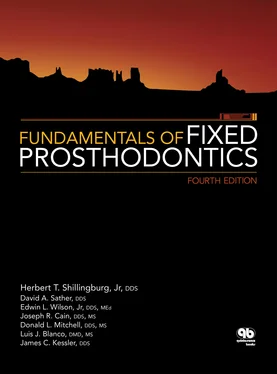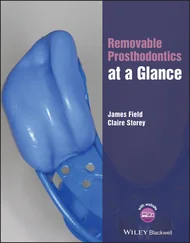| Missing: Maxillary canine Abutments: Central incisor, lateral incisor, and first premolar Considerations: A single implant-supported MCR crown would be the restoration of choice here. Restore the occlusion to group function. Using the two premolars and the lateral incisor as abutments is not desirable because it places too heavy a burden on the smaller single abutment, the lateral incisor. Retainers: MCR crowns Pontic: Modified ridge lap or ovate MCR, depending on the faciolingual dimension of the ridge Abutment-pontic root ratio: 2.3 |
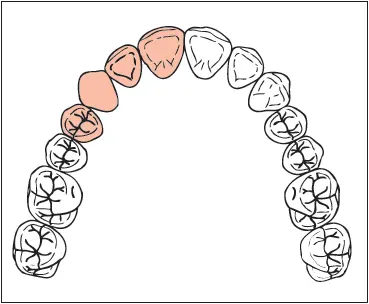 |
 |
Missing: Maxillary canine Implant: 4.5 × 15 mm Considerations: A dental implant is the restoration of choice. Restoration: MCR over a custom abutment (UCLA, Atlantis, or preparable abutment) |
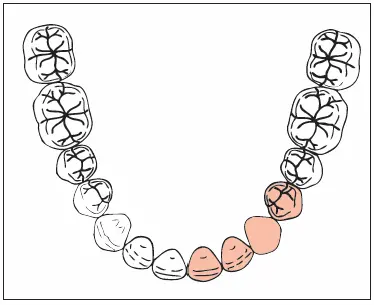 |
Missing: Mandibular canine Abutments: Central incisor, lateral incisor, and first premolar Considerations: An implant-supported MCR is the restoration of choice in the mandible as well. Use group function to restore the occlusion. If there has been extensive bone loss around the lateral incisor, or if it is tilted to produce a line of draw discrepancy, remove the lateral incisor and use both central incisors as abutments if a fixed partial denture is used. Fortunately, the need to replace this tooth is not common. Retainers: MCRs Pontic: Ovate MCR Abutment-pontic root ratio: 1.9 |
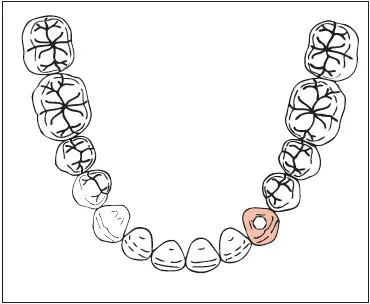 |
Missing: Mandibular canine Implant: 4.5 × 15 mm Considerations: A dental implant is the restoration of choice. Restoration: MCR over a custom abutment (UCLA, Atlantis, or preparable abutment) |
| Missing: Maxillary central incisor and lateral incisor Abutments: Central incisor and canine Considerations: If the central incisor and canine are unblemished and unusually large, pin-modified partial coverage crowns could be used. Patient acceptance and dentist skill are strong considerations. Retainers: MCRs Pontics: Modified ridge lap MCR Abutment-pontic root ratio: 1.2 |
 |
| Missing: Maxillary central incisor and lateral incisor Implants: 4.0 × 12 mm (central incisor), 3.5 × 12 mm (lateral incisor) Considerations: A large nasopalatine foramen (incisive canal) may interfere with implant placement. If loss of the lateral incisor has caused loss of the facial plate of bone, the resulting facial concavity will place the implant too far to the lingual. This may necessitate bone grafting to eliminate the facial concavity. Splinting the dental implant restoration will reduce rotational forces on the abutment screws, lessening the possibility of screw loosening. Splinting the dental implants will increase restoration strength and stress distribution. Restorations: MCRs over custom abutments (UCLA, Atlantis, or preparable abutments) |
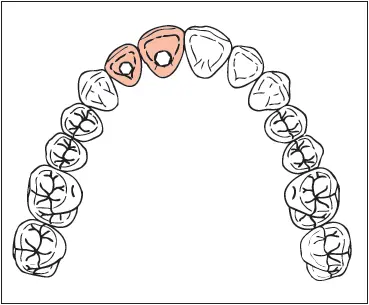 |
| Missing: Mandibular central incisors Abutments: Lateral incisors Considerations: If there has been any bone loss around the lateral incisors, or if they are malpositioned, remove them. Use MCR retainers on the canines for a tooth-borne fixed partial denture. Retainers: Resin-bonded retainers if the abutments are unblemished Pontics: Ovate MCRs or one-piece pontics with a modified ridge lap of pink porcelain Abutment-pontic root ratio: 1.1 |
 |
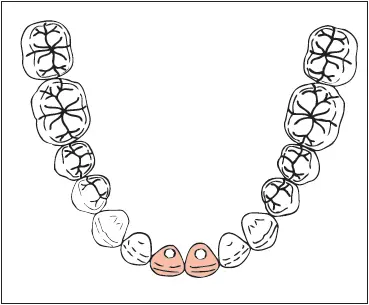 |
Missing: Mandibular central incisors Implants: 3.3 × 12 mm Considerations: The factor limiting replacement of mandibular central incisors with dental implants is the mesiodistal space available. Ideally there should be 12.6 mm of interproximal space. If inadequate space is available, consider extraction of the lateral incisors. Place two 4.0 × 12–mm dental implants in the lateral incisor positions and fabricate a four-unit fixed partial denture. Splinting the dental implant restoration will reduce rotational forces on the abutment screws, lessening the possibility of screw loosening. Splinting the dental implants will increase restoration strength and stress distribution. Restorations: MCRs over one-piece implants |
|
|
 |
Missing: Maxillary first and second premolars Abutments: Canine and first molar Considerations: An MCR crown may be used on the molar if the mesiofacial cusp is damaged or undermined or if the patient requests it. An MCR will be required on the canine. Retainers: MCR on the canine and ⅞ crown or MCR on the molar Pontics: Modified ridge lap MCRs Abutment-pontic root ratio: 1.6 |
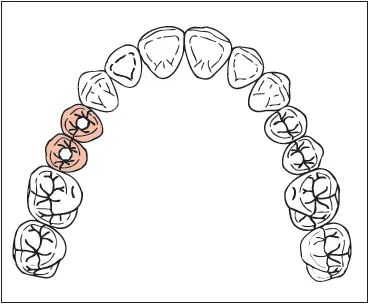 |
Missing: Maxillary first and second premolars Implants: 4.0 × 13 mm (first premolar), 4.3 × 11.5 mm (second premolar) Considerations: The loss of the facial plate of bone will frequently result in a facial concavity, requiring implant placement too far to the lingual. This will result in an unnatural lingual contour of the crown and a poor implant emergence profile. To correct this problem, bone grafting is required to eliminate the facial concavity. The maxillary sinus will likely interfere with the placement of an implant of desirable length, necessitating sinus modification surgery such as a sinus graft or a vertical upfracture. Splinting the dental implant restoration will reduce rotational forces on the abutment screws, lessening the possibility of screw loosening. Splinting the dental implants will increase restoration strength and stress distribution. Restorations: MCRs over custom abutments (UCLA, Atlantis, or preparable abutments) |
| Missing: Mandibular first and second premolars Abutments: Canine and first molar Considerations: If the molar has tilted mesially, orthodontic uprighting or preparation modification will be required. The patient’s esthetic expectations may require an MCR crown on the molar. Retainers: MCR crown on the canine and FGC on the molar Pontics: Ovate MCRs Abutment-pontic root ratio: 1.8 |
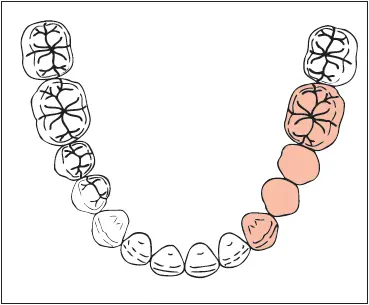 |
| Missing : Mandibular first and second premolars Implants : 4.3 × 11.5 mm (first premolar), 4.3 × 10 mm (second premolar) Considerations : The position of the anterior loop of the mandibular canal may interfere with implant placement. Loss of the facial plate of bone may result in inadequate alveolar width. Alveolar resorption may result in insufficient height of bone above the mandibular canal. The correction of this anatomical difficulty requires the placement of an onlay bone graft to allow the placement of an implant of sufficient width and length. Splinting the dental implant restoration will reduce rotational forces on the abutment screws, lessening the possibility of screw loosening. Splinting the dental implants will increase restoration strength and stress distribution. Restorations : MCRs over custom abutments (UCLA, Atlantis, or preparable abutments) |
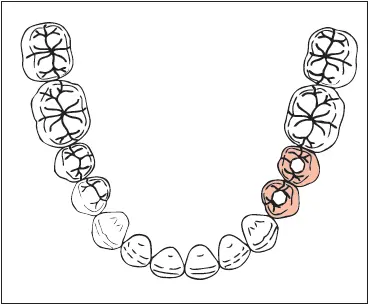 |
| Missing: Maxillary second premolar and first molar Abutments: First premolar and second molar Retainers: MCR crown on the premolar and FGC on the molar. Discourage the patient from choosing an MCR for the molar. An FGC probably will not be visible, and its preparation does not require the destruction of nearly as much tooth length or bulk. Pontics: Modified ridge lap MCRs Abutment-pontic root ratio: 1.0 |
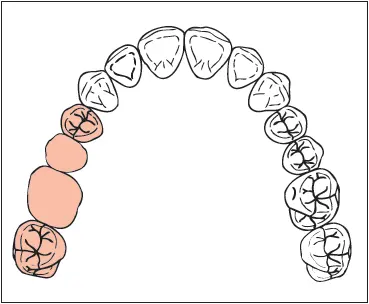 |
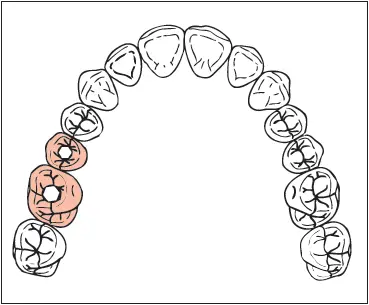 |
Missing: Maxillary second premolar and first molar Implants: 4.3 × 11.5 mm (second premolar), 5.0 × 11.5 mm (first molar) Considerations: The loss of the facial plate of bone will frequently result in a facial concavity requiring implant placement too far to the lingual. This will result in an unnatural lingual contour of the crown and a poor implant emergence profile. To correct this problem, bone grafting is required to eliminate the facial concavity. The maxillary sinus will likely interfere with the placement of an implant of desirable length, necessitating sinus modification surgery such as a sinus graft or a vertical upfracture. Splinting the dental implant restoration will reduce rotational forces on the abutment screws, lessening the possibility of screw loosening. Splinting the dental implants will increase restoration strength and stress distribution. Restorations: MCRs over custom abutments (UCLA, Atlantis, or preparable abutments) |
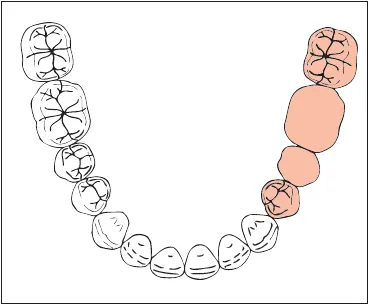 |
Missing: Mandibular second premolar and first molar Abutments: First premolar and second molar Considerations: If the premolar root is short or thin, or if the clinical crown is very small, the canine should be included as a secondary abutment. Retainers: MCR crown on the premolar and FGC on the molar Pontics: Modified ridge lap or ovate MCRs Abutment-pontic root ratio: 1.0 |
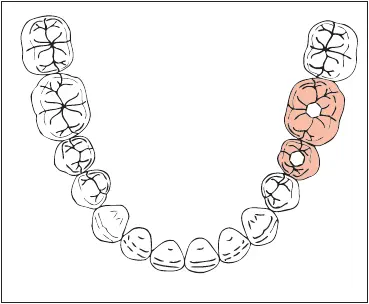 |
Missing: Mandibular second premolar and first molar Implants: 4.3 × 10 mm (second premolar), 5.0 × 10 mm (first molar) Considerations: Loss of the facial plate of bone may result in inadequate alveolar width. Alveolar resorption may result in insufficient height of bone above the mandibular canal. The correction of this anatomical difficulty requires the placement of an onlay bone graft to allow the placement of an implant of sufficient width and length. Splinting the dental implant restoration will reduce rotational forces on the abutment screws, lessening the possibility of screw loosening. Splinting the dental implants will increase restoration strength and stress distribution. Restorations: MCRs over custom abutments (UCLA, Atlantis, or preparable abutments) |
| Missing: Maxillary first and second molars Considerations: A fixed partial denture cannot be used in this situation because there is no distal abutment. Missing: Maxillary first and second molars Implants: 5.0 × 11.5 mm Considerations: The placement of a dental implant in the second molar position provides increased strength and stress distribution of occlusal and antirotational forces. The maxillary sinus will likely interfere with the placement of an implant of desirable length, necessitating sinus modification surgery such as a sinus graft or a vertical upfracture. Splinting the dental implant restoration will reduce rotational forces on the abutment screws, lessening the possibility of screw loosening. Splinting the dental implants will increase restoration strength and stress distribution. Restorations: MCR over a custom abutment (UCLA, Atlantis, or preparable abutment) for the first molar and FGC or MCR over a custom abutment for the second molar |
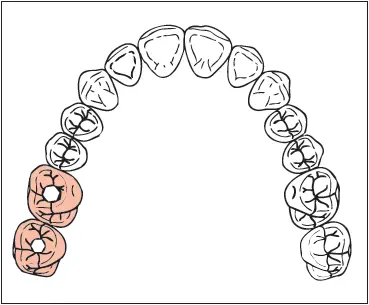 |
| Missing: Mandibular first and second molars Considerations: A fixed partial denture cannot be used in this situation because there is no distal abutment and a cantilever would place excessive force on the premolars. Missing: Mandibular first and second molars Implants: 5.0 × 10 mm Considerations: The placement of a dental implant in the second molar position provides increased strength and stress distribution of occlusal and antirotational forces. Loss of the facial plate of bone may result in inadequate alveolar width. Alveolar resorption may lead to insufficient height of bone above the mandibular canal. The correction of this anatomical difficulty requires the placement of an onlay bone graft to allow the placement of an implant of sufficient width and length. Splinting the dental implant restoration will reduce rotational forces on the abutment screws, lessening the possibility of screw loosening. Splinting the dental implants will increase restoration strength and stress distribution. Restorations: MCRs or FGCs over custom abutments (UCLA, Atlantis, or preparable abutments) |
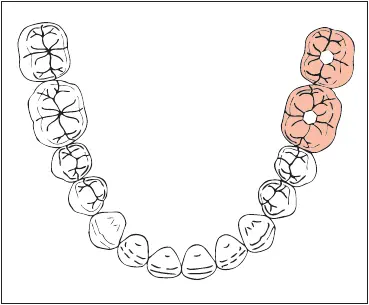 |
